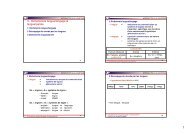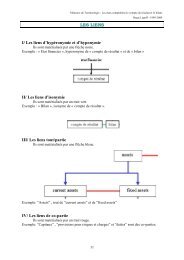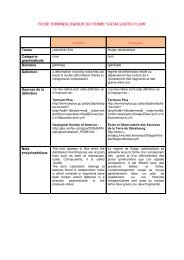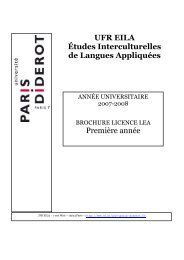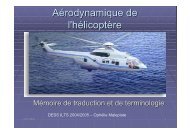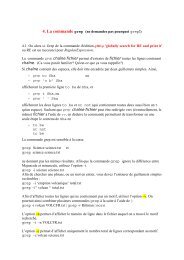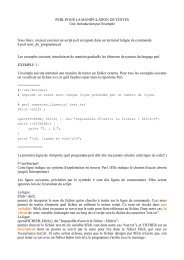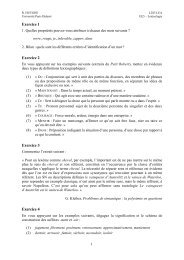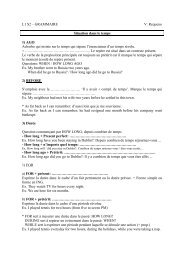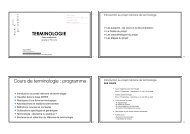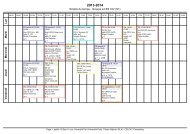INTRODUCTION TO ENGLISH TEXT LINGUISTICS
INTRODUCTION TO ENGLISH TEXT LINGUISTICS
INTRODUCTION TO ENGLISH TEXT LINGUISTICS
Create successful ePaper yourself
Turn your PDF publications into a flip-book with our unique Google optimized e-Paper software.
Professor Christopher Gledhill<br />
(Notes de cours, Linguistique du texte anglais, 48LGAN23, EILA, Université Paris Diderot)<br />
<strong>TEXT</strong> 1<br />
Not All Volcanoes Are Alike.<br />
Not all volcanic eruptions are as violent as the 1980 Mount St. Helens event. Some volcanoes,<br />
such as Hawaii's Kilauea volcano, generate relatively quiet out pourings of fluid lavas (Figure 4.5).<br />
These "gentle" eruptions are not without some fiery displays; occasionally fountains of<br />
incandescent lava spray hundreds of meters into the air. Such events, however, are typically shortlived<br />
and harmless, and the lava generally falls back into a lava pool.<br />
Why do volcanoes like Mount St. Helens erupt explosively, whereas others like Kilauea are<br />
relatively quiet? Why do volcanoes occur in chains like the Aleutian Islands or the Cascade Range?<br />
Why do some volcanoes form on the ocean floor, while others occur on the continents? This<br />
chapter will deal with these and other questions as we explore the formation and movement of<br />
magma.<br />
Composite Cones.<br />
Earth's most picturesque volcanoes are composite cones. Most active composite cones are in a<br />
narrow zone that encircles the Pacific Ocean, appropriately named the Ring of Fire. In this region<br />
are Fujiyama (Mt. Fuji) in Japan, Mount Mayon in the Philippines, and the picturesque volcanoes<br />
of the Cascade Range in the northwestern United States, including Mount St. Helens, Mount<br />
Rainier, and Mount Shasta (Figure 4.13).<br />
A composite cone or stratovolcano is a large, nearly symmetrical structure composed of<br />
alternating lava flows and pyroclastic deposits, emitted mainly from a central vent. Just as shield<br />
volcanoes owe their shape to the highly fluid nature of the extruded lavas, so too do composite<br />
cones reflect the nature of the erupted material.<br />
Composite cones are produced when relatively viscous lavas of andesitic composition are<br />
extruded. A composite cone may extrude viscous lava for long periods. Then, suddenly, the<br />
eruptive style changes and the volcano violently ejects pyroclastic material. Most of it falls near<br />
the summit, building a steep-sided mound of cinders. In time, this debris becomes covered by<br />
new lava. Occasionally, both activities occur simultaneously.<br />
(Lutgens, Frederick K. & Edward J. Tarbuck, 2012. Essentials of geology [3rd edition]. New Jersey:<br />
Pearson Prentice Hall, p103)<br />
<strong>TEXT</strong> 2<br />
Lava dome growth at the Soufrière Hills Volcano has frequently been accompanied by repetitive<br />
cycles of earthquakes, ground deformation, degassing and explosions (Voight et al., 1999 B.<br />
Voight, R.S.J. Sparks and A.D. Miller, et al. Magma flow instability and cyclic activity at Soufriere<br />
Hills Volcano, Montserrat, British West Indies. Science, 283 (1999), pp. 1138–1142). The cyclic<br />
behaviour can occur on a wide range of timescale but here we are concerned with cycles of<br />
activity that repeat with periods of hours to days. That is, cycles which are not accompanied by<br />
Vulcanian explosions that occur on timescales of weeks to months. Deformation of the volcano<br />
flanks have been measured using tilt-metres but it has also been observed that large fractures<br />
31 / 37




